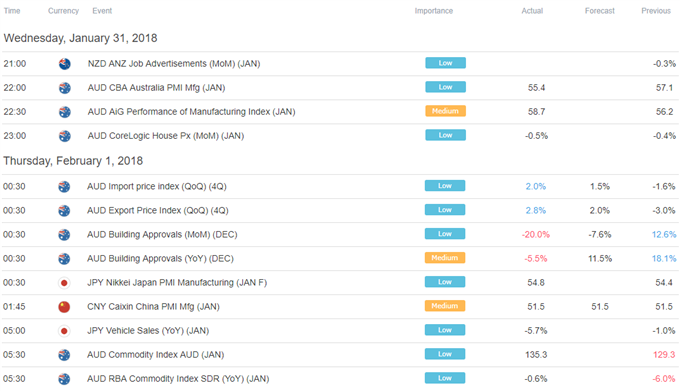Talking Points:
- Australian Dollar sinks on disappointing economic data, political jitters
- Japanese Yen down as Asia Pacific stocks bounce after 3 days of losses
- US Dollar attempting recovery but soft ISM result might cool momentum
The Australian Dollar underperformed in overnight trade, falling against all of its major counterparts. The selloff began with deeply disappointing building permits data, then followed further fuel in RBA statistics showing the price of Australia’s exports on global markets fell for a third consecutive month in January.
Political jitters may have helped as well as yet another Member of Parliament resigned after admitting that he was unable to confirm that he’d renounced his British citizenship. A rule forbidding Australian MPs from being citizens of any other country hit the spotlight last year, culling the ranks of unsuspecting lawmakers.
Perhaps most critically, the currency fell alongside local front-end bond yields. That signaled that the RBA monetary policy outlook had deteriorated, regardless of which bit of news flow was the decisive catalyst. The priced-in timing of the next rate hike has been pushed back to August to November.
The Japanese Yen also fell as regional share prices rebounded after three days of losses, putting pressure on the perennially anti-risk currency. The MSCI Asia Pacific regional benchmark equity index added 0.7 percent. Japan’s own Nikkei 225 added nearly 2 percent after the largest six-day drop since November 2016.
The US Dollar turned higher. The benchmark currency fell in the wake of Donald Trump’s first State of the Union address but subsequently erased most of the drop after the rate-setting FOMC committee issued a policy statement that was a bit more upbeat on reflation prospects, implying a cautiously hawkish bias.
It appears as though Asia Pacific markets assigned more significance to the rhetorical shift than their North American counterparts. Indeed, the greenback tellingly advanced alongside front-end Treasury bond yields, implying a supportive pivot in investors’ baseline Fed policy outlook.
Looking ahead, a quiet day on European data front is likely to put US releases in focus. The manufacturing ISM survey is on tap, with expectations pointing to a slowdown in the pace of factory-sector growth. A soft result echoing recent disappointments in US statistics may cap the nascent USD recovery.
Check out our free guide to see DailyFX analysts’ top trading ideas for 2018 !
Asia Session

European Session

** All times listed in GMT. See the full DailyFX economic calendar here.
--- Written by Ilya Spivak, Currency Strategist for DailyFX.com
To receive Ilya's analysis directly via email, please SIGN UP HERE
Contact and follow Ilya on Twitter: @IlyaSpivak




